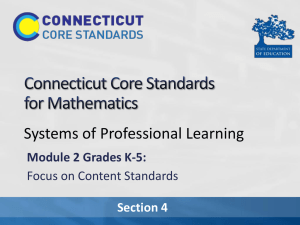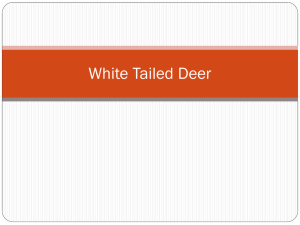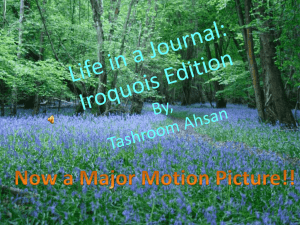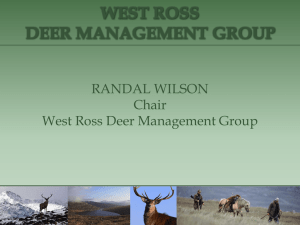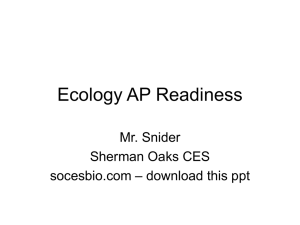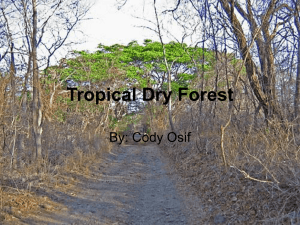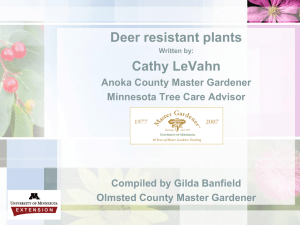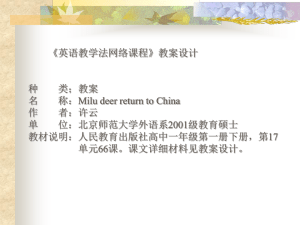Deer Management Assistance Program
advertisement
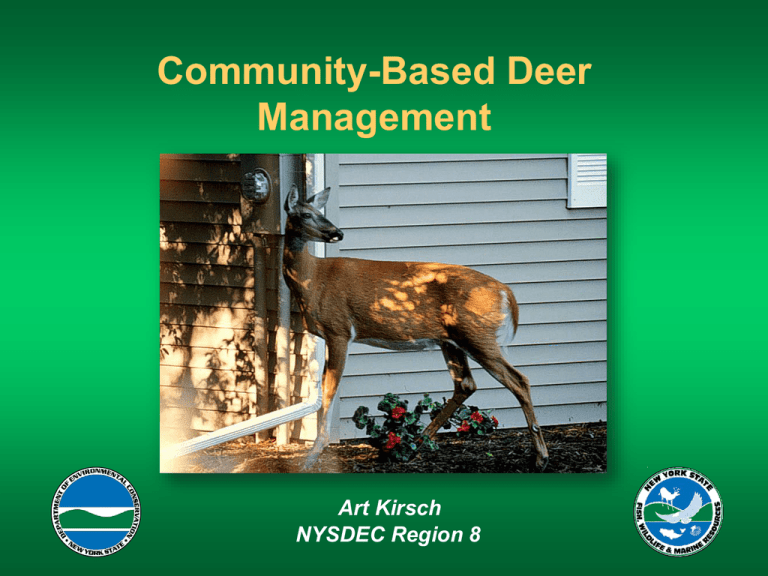
Community-Based Deer Management Art Kirsch NYSDEC Region 8 Is there a problem? The Traditional Concerns • Ornamental damage • Deer-related vehicle accidents • Ecological damage • Aggressive deer (rarely) • Disease transmission If everyone is in agreement as to the course of action, then by all means, round up the posse! But if Avon is like the other 493 communities in the US who have experienced urban/suburban deer problems over the last 30 years, the social aspects of the issue will be as important to address as the biological, and should come first. How to Guarantee That Efforts to Solve a Community Deer Issue Will Fail Include only one or two perspectives Have no structured decision-making process Skip right to the action phase Ignore people’s opinions Have no real ground rules Don’t consider who your stakeholders are Keep information to yourself Ignore pertinent information Harbor hidden agendas Give up when the going gets a little tough Expect a “magic bullet” that you only need to take once Don’t learn from your successes and failures Essential Elements for Success Include multiple perspectives Create a structured decision-making process Form universally accepted ground rules Identify your stakeholders Share understandings among stakeholders Build a shared, comprehensive information base Foster full disclosure of stakeholder goals Believe that acceptable solutions are worth seeking Understand that community-based deer management is an ongoing process, not a one-time event Commit to systematic evaluation of the decision-making process and subsequent management program The Community-Based Deer Management Process Recognition of problem Evaluation Definition of Objectives Implementation Identification of acceptable methods Selection of options Fencing •• •Should relate to the High Did actions awareness address of the Community notification •problem Repellents issue and improve within the original • Who? •• •Must bebe acceptable to Planting community problem? Should easily • measured When? community recommendations • the Consensus To what extent? within the Time frame ••• •Must be affordable Does not necessarily Fertility control community that a Were costs on target? Who pays? knowing how (experimental) problem exists and •• require How long will ithappy? take? Is community deer live in the something should be • •many Safety addressed? Managed hunting What is the potential • Any unforeseen neg. for community done • •consequences? Venison Damagedisposition permits success? • •Clarification of just (ifand deer killed) Bait Shoot • Can process be made what the problem is • •better Reporting of results Trap or and transfer more •efficient? Other Reducing Plant Damage • Repellents may work when deer pressure and damage is light • Fencing provides reliable control when deer damage is moderate to heavy • Manage herd density where possible • Deer feeding is illegal in NYS • Choose plants that are less attractive to deer Plant Palatability Plan Your Planting! Factors Influencing Deer Feeding Pressure • • • • • • • Deer population density Food & cover sources Travel corridors Alternative foods Season & weather Deer nutrition Plant palatability & nutrients • Previous experience • Presence of dogs Repellents • • • • • • • • BGR Deer-Away Hinder Deer-Off Chew-Not (20% thiram) Bonide Rabbit/Deer Repellent Hot Sauce Repellent Tree Guard Other Deer Exclusion Alternatives • 8-foot woven-wire fences • Electric fences • Individual plant protection • Dogs Avoiding Deer-Vehicle Collisions • Driver education • Speed limit reductions and enforcement • Peak months Oct, Nov, and Dec • Be extra careful at dawn and dusk • Heed deer crossing signs; they’re there for a reason Avoiding Collisions (continued) • Scan the roadsides for eye reflections • Watch where deer came from, not where they’re going • Manage herd density where possible • Do special roadside reflectors work? • What about deer whistles? Deer Population Reduction • Fertility control • Managed hunting • Deer Management Assistance Program (DMAP) • Deer damage permits • Special urban deer permits (such as bait and shoot) • Trap and Transfer Fertility Control • Still experimental • Only permitted in communities involved with scientific research • Costly • Does not reduce existing population • Takes years before possible results seen • A one-dose vaccine is being tested, but awaits FDA approval DMAP • Deer Management Assistance Program • Additional antlerless tags from DEC for use during hunting season • For specific properties • Categories: – – – – – Agricultural Municipality Significant Natural Communities Forest Regeneration Custom Deer Management Managed Hunting • Landowners have full control of what they allow on their property – – – – – Days hunted Hunt timing Location Hunter numbers Hunter characteristics (ethics, proficiency, trustworthiness, etc) • Can require removal of one or more female deer before buck (“Earn-a-Buck”) • May be discharge of firearms restrictions in place that would limit this option (variance?) • There are ways to address safety concerns Deer Damage Permits • Site specific • Usually agricultural damage only • To address damage on crops not yet harvested • Usually for antlerless deer only • For use outside of the hunting season Special Urban Deer Permits • Issued to a municipality • Geared toward population reduction • Covering such activities as “Bait and Shoot” For more information: or visit: www.dec.ny.gov

